Russia’s Crude Exports Start 2024 In Line With Pledged OPEC+ Cut
Shipments were 300,000 barrels a day below May-June average in the first week of 2024

(Bloomberg) -- Russia’s seaborne crude shipments began 2024 exactly in line with Moscow’s pledge to cut the country’s exports as part of the wider OPEC+ effort to stabilize global oil markets.
About 3.34 million barrels a day of crude were shipped from Russian ports in the four weeks to Jan. 7, tanker-tracking data monitored by Bloomberg show. That was down by 120,000 barrels a day from the period to Dec. 31.
The more volatile weekly average fell by 500,000 barrels a day to 3.28 million. That was 300,000 barrels below the average export level seen by Bloomberg during May and June, which is the baseline period used by Moscow for the reduction in crude exports that it has pledged to its OPEC+ partners in the first quarter of 2024.
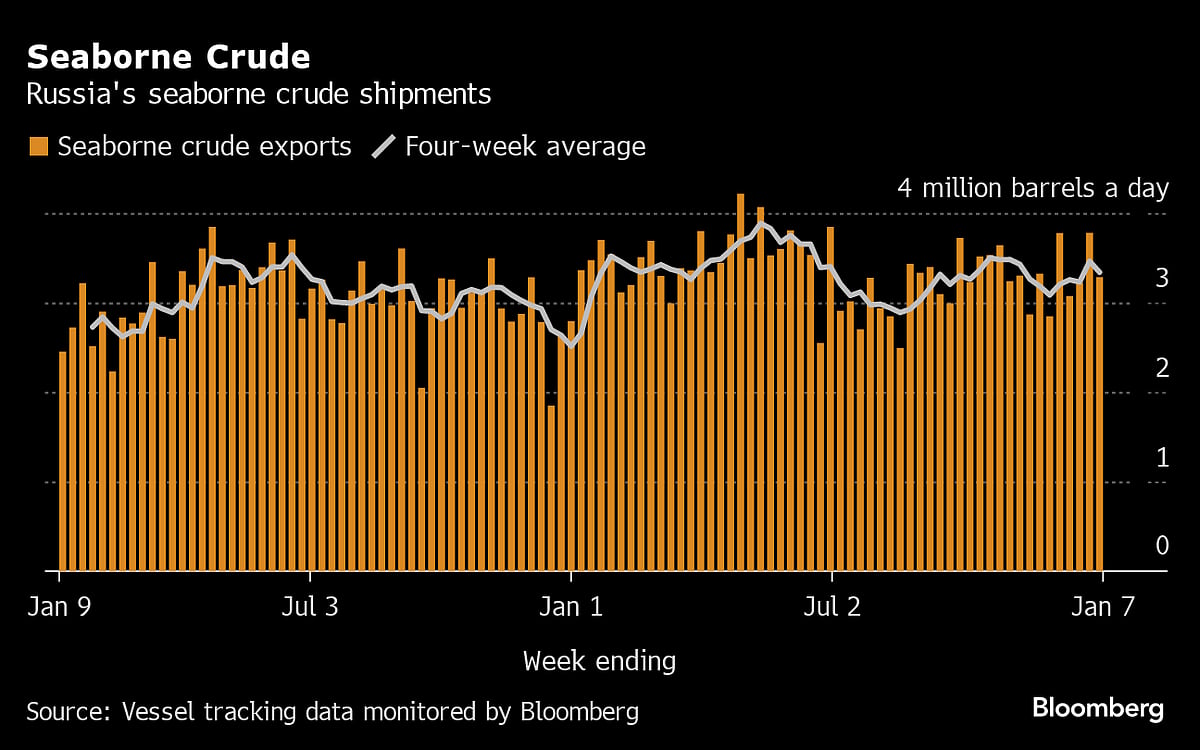
Russia has said it will deepen its oil export cuts to 500,000 barrels a day below the May-June average during the first quarter, after Saudi Arabia said it would prolong its unilateral one-million-barrel-a-day supply reduction and several other members of the OPEC+ group agreed to make further output curbs. The Russian cut will be shared between crude shipments, which will be reduced by 300,000 barrels a day, and refined products. The four-week average crude measure was about 245,000 barrels a day below the May-June level.
All Russian crude destined for Asian buyers after being loaded at western ports continues to pass through the Red Sea, despite attacks on merchant vessels from Yemen-based Houthi rebels. Tankers carrying Moscow’s oil are unlikely to be targeted, but that doesn’t rule out the risk of a ship carrying Russian supplies being hit by mistake.
Russia appears to be struggling to place cargoes of its Sokol crude. Six ships that were heading for the ports of Paradip and Vadinar came to a halt in December before heading back through the Strait of Malacca. Three of those tankers signaled a new destination of Qingdao in China, but have stopped for a second time in the South China Sea.
Four more cargoes of Sokol have been loaded onto ships that are also showing ports in India. They too are showing no sign of heading to their designated destinations.
The gross value of Russia’s crude exports, calculated from weekly shipments and Argus Media pricing data, fell to $1.45 billion in the seven days to Jan. 7 from $1.73 billion the previous week. Four-week average income also slipped, decreasing by $53 million to $1.5 billion a week.
Flows by Destination
Russia’s seaborne crude flows in the four weeks to Jan. 7 fell to 3.34 million barrels a day. That was down from 3.46 million barrels a day in the period to Dec. 31. Shipments were about 245,000 barrels a day below the average seen in May and June.

All figures exclude cargoes identified as Kazakhstan’s KEBCO grade. Those are shipments made by KazTransoil JSC that transit Russia for export through Novorossiysk and the Baltic port of Ust-Luga and are not subject to European Union sanctions or a price cap.
The Kazakh barrels are blended with crude of Russian origin to create a uniform export grade. Since Russia’s invasion of Ukraine, Kazakhstan has rebranded its cargoes to distinguish them from those shipped by Russian companies.
-
Asia
Observed shipments to Russia’s Asian customers, including those showing no final destination, edged lower to 2.96 million barrels a day in the four weeks to Jan. 7, down from a two-month high of 2.99 million barrels a day in the period to Dec. 31.
About 1.19 million barrels a day of crude was loaded onto tankers heading to China in the four weeks to Jan. 7. China’s seaborne imports are supplemented by about 800,000 barrels a day of crude delivered directly from Russia by pipeline, either directly, or via Kazakhstan.
Flows on ships signaling destinations in India averaged about 910,000 million barrels a day in the four weeks to Jan. 7.
Both the Chinese and Indian figures will rise as the discharge ports become clear for vessels that are not currently showing final destinations.
The equivalent of about 710,000 barrels a day was on vessels signaling Port Said or Suez in Egypt, or are expected to be transferred from one ship to another off the South Korean port of Yeosu. Those voyages typically end at ports in India or China and show up in the chart below as “Unknown Asia” until a final destination becomes apparent.
The “Other Unknown” volumes, running at about 160,000 barrels a day in the four weeks to Dec. 31, are those on tankers showing no clear destination. Most of those cargoes originate from Russia’s western ports and go on to transit the Suez Canal, but some could end up in Turkey. Others could be moved from one vessel to another, with most such transfers now taking place in the Mediterranean, off the coast of Greece.
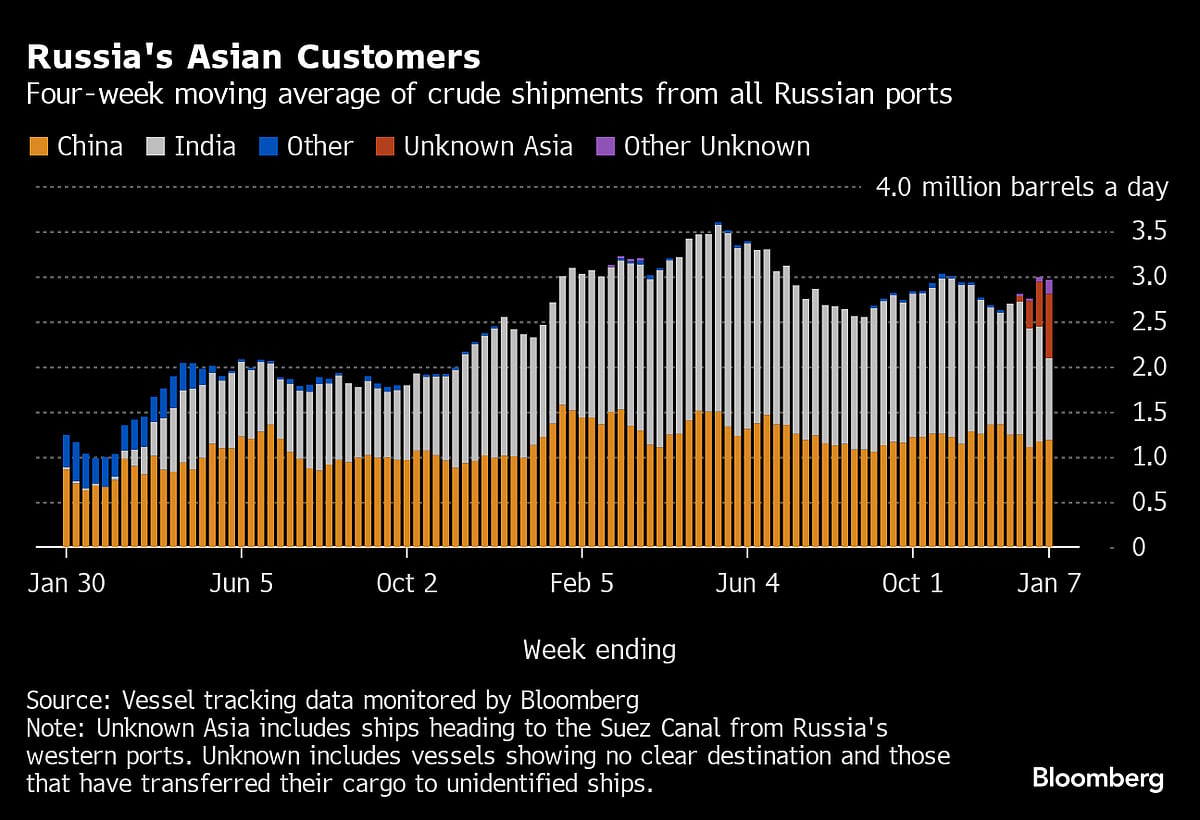
Europe and Turkey
Russia’s seaborne crude exports to European countries have collapsed since Moscow’s troops invaded Ukraine in February 2022. A market that consumed about 1.5 million barrels a day of short-haul seaborne crude, coming from export terminals in the Baltic, Black Sea and Arctic has been lost almost completely, to be replaced by long-haul destinations in Asia that are much more costly and time-consuming to serve.
Combined flows to Turkey and Bulgaria, Russia’s only two remaining buyers close to its western ports, fell to about 380,000 barrels a day in the four weeks to Jan. 7, tanker-tracking data show. That’s the lowest in three months.
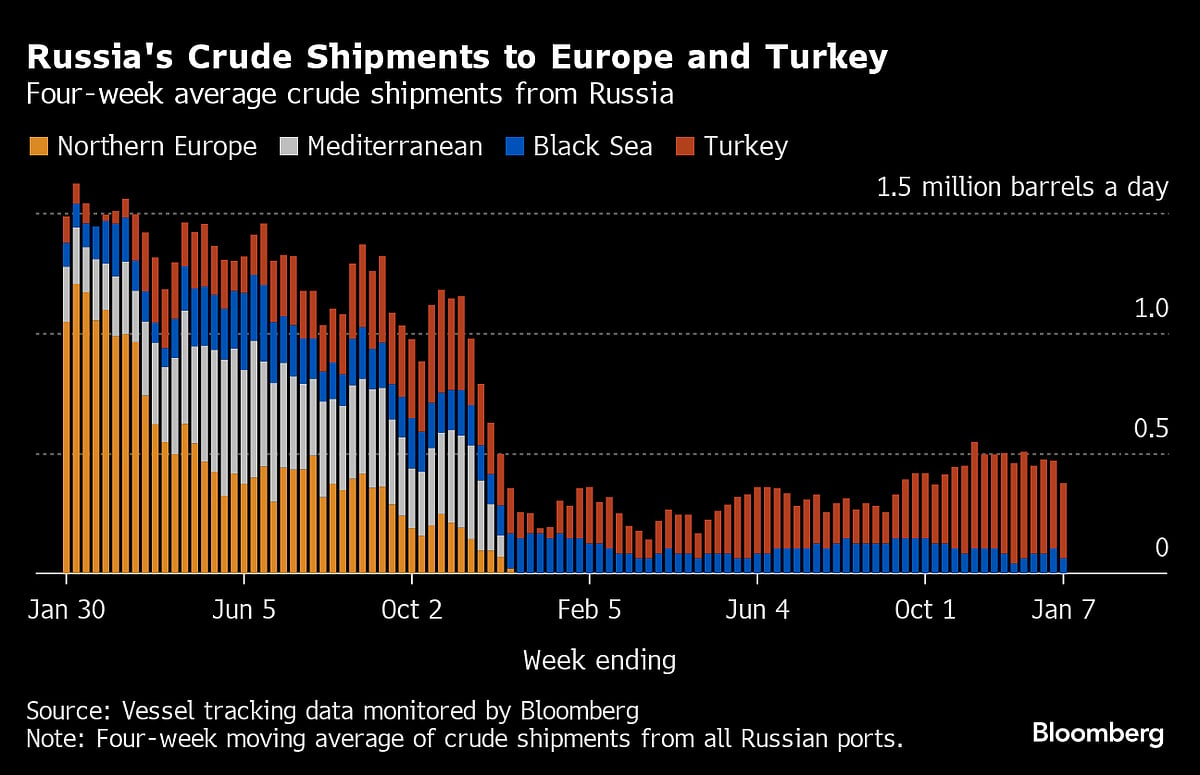
Exports to Turkey fell to about 313,000 barrels a day in the four weeks to Jan. 7. They are still close to three times as high as the lows they hit in July and August.
Flows to Bulgaria, now Russia’s only European market for crude, slipped to a four-week low of about 63,000 barrels a day in the most recent four-week period. Bulgaria’s parliament has approved a measure that will end imports of Russian oil from March, nine months earlier than permitted under an exemption to EU sanctions on purchases of Moscow's oil.
No Russian crude was shipped to northern European countries, or those in the Mediterranean in the four weeks to Jan. 7.
Vessel-tracking data are cross-checked against port agent reports as well as flows and ship movements reported by other information providers including Kpler and Vortexa Ltd.
Export Value
Following the abolition of export duty on Russian crude, we have begun to track the gross value of seaborne crude exports, using Argus Media price data and our own tanker tracking.
The gross value of Russia’s crude exports fell to $1.45 billion in the seven days to Jan. 7 from $1.73 billion the previous week. Meanwhile four-week average income also slipped, decreasing by $53 million to $1.5 billion a week. The four-week average peaked at $2.17 billion a week in the period to June 19, 2022. The highest it reached last year was $2 billion a week in the period to Oct. 22.
During the first four weeks after the Group of Seven nations’ price cap on Russian crude exports came into effect in early December, 2022, the value of seaborne flows fell to a low of $930 million a week, but soon recovered.
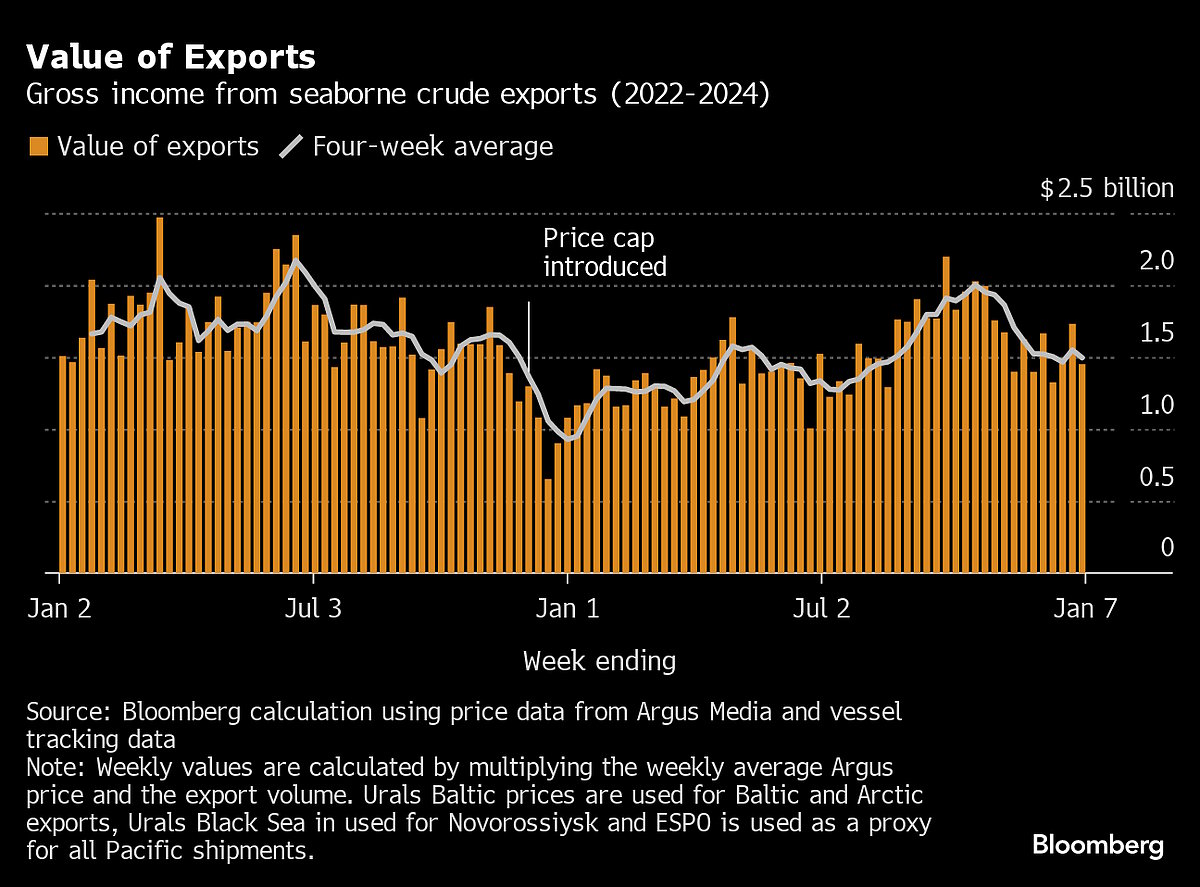
The chart above shows a gross value of Russia’s seaborne oil exports on a weekly and four-week average basis. The value is calculated by multiplying the average weekly crude price from Argus Media Group by the weekly export flow from each port. For shipments from the Baltic and Arctic ports we use the Urals FOB Primorsk dated, London close, midpoint price. For shipments from the Black Sea we use the Urals Med Aframax FOB Novorossiysk dated, London close, midpoint price. For Pacific shipments we use the ESPO blend FOB Kozmino prompt, Singapore close, midpoint price.
Export duty was abolished at the end of 2023 as part of Russia’s long-running tax reform plans.
Origin-to-Location Flows
The following table shows the number of ships leaving each export terminal.
A total of 30 tankers loaded 23 million barrels of Russian crude in the week to Jan. 7, vessel-tracking data and port agent reports show. That was down by about 3.5 million barrels from the previous week’s six-month high.
Strong winds at Kozmino, topping 50 miles an hour according to weather data provide Visual Crossing, is likely to have hampered mooring operations toward the end of the week, when loading slowed.
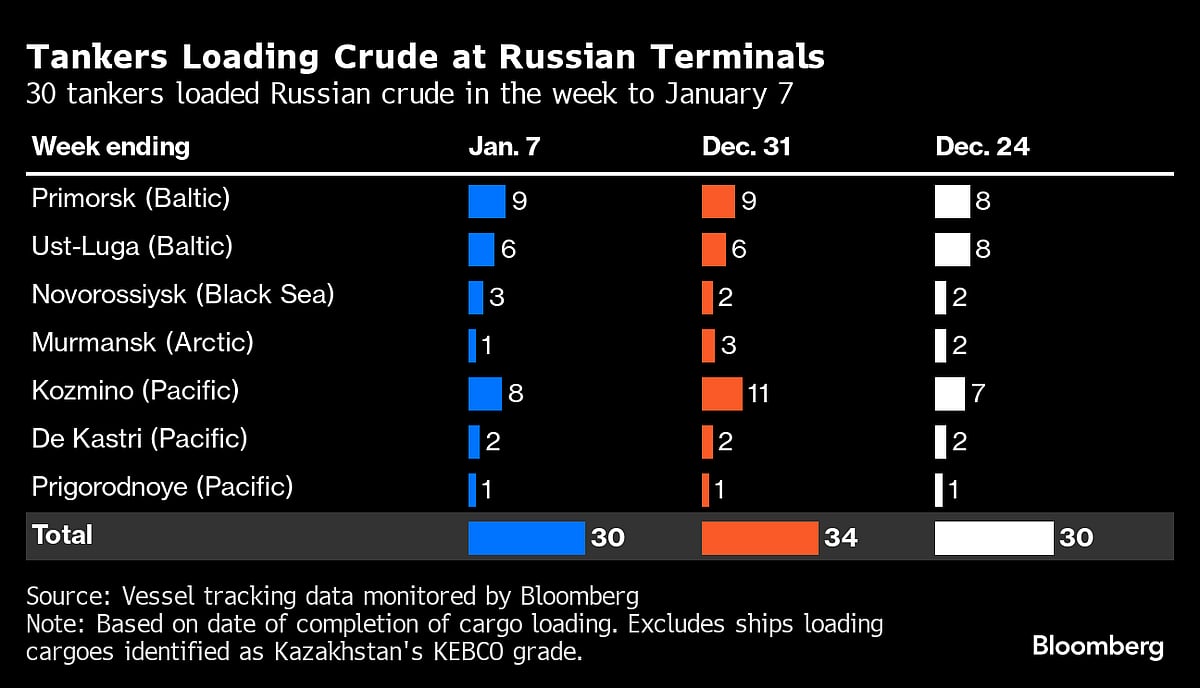
All figures exclude cargoes identified as Kazakhstan’s KEBCO grade. One cargo of KEBCO was loaded at Novorossiysk and one at Ust-Luga during the week.
NOTES
Note: This story forms part of a weekly series tracking shipments of crude from Russian export terminals and the export duty revenues earned from them by the Russian government. Weeks run from Monday to Sunday. The next update will be on Tuesday, Jan. 16.
Note: All figures exclude cargoes owned by Kazakhstan’s KazTransOil JSC, which transit Russia and are shipped from Novorossiysk and Ust-Luga as KEBCO grade crude.
If you are reading this story on the Bloomberg terminal, click here for a link to a PDF file of four-week average flows from Russia to key destinations.
--With assistance from Sherry Su.
More stories like this are available on bloomberg.com
©2024 Bloomberg L.P.